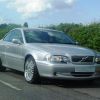The typical squeal is caused by high frequency resonance between the back of the pad and the caliper - usually this happens on our cars at low speeds with gentle pressure applied - wherein the pad has more opportunity to move against the caliper piston. The rear braking system on our cars consists of a pair of pistons, a pair of pads and the disk. As the brake pedal is applied the pad will move upwards a little - to the upper end of the pad slot in the caliper. As time goes on I believe bashing of the end of the pad against the wall of the slot causes there to be a little more room than when they were new. The pads at low braking speed/pressure can move that little bit up and down in the slot - causing them to squeal. The hollow pistons and the disk act as amplifiers of the sound
The use of copper slip is supposed to reduce this resonance, as is shamfering the edges of the pad braking surface. I have tried these methods and they usually work, but not alas on ours. The silicon shims seem to be the only way to stop this irritation, by dampening the contact surface between pad and piston.
Installation of Self-Adhesive Silicone Shims
This how-to also covers the removal and replacement of the 850/V/S/C70 P1 Rear Brake pads.
1. loosen (but do not remove) the wheel nuts with the car on the deck
2. Jack up the car - Think safe. Do it on a level surface with the car in gear or park (auto). Use an axel stand as protection. Use suitable jacking points on the chassis.
3. Remove the wheel nuts and the wheel
4. Tap the 2 pins on the rear edge of the caliper and drive them out with a punch, until the springs on the pins are free. There is one pin at the top and bottom of the caliper.
Couple of taps is all that is required - don't go mad!
http://www.bigredvolvos.co.uk/images.../pins_out1.jpg
5. Note how the anti-rattle spring sits then slide the pins out of the back of the caliper with pliers, careful not to lose the spring. (apologies for the framing)
http://www.bigredvolvos.co.uk/images...nd_springs.jpg
6. If you are replacing the pads then you can remove both. If the pads are to go back in (with the shims) then do the removal and sanding as described one at a time or remember which pad was inboard and which was outboard.
7. Remove the pads. Don't pry against the disk, you may damage it. Use the holes that the pins go through and wiggle them out with narrow nose pliers. TBH they should come out very easily.
8.Sand the back of the pad.
http://www.bigredvolvos.co.uk/images...k/sand_pad.jpg
9. Cut out the shims. The ones I use are silicon self adhesive ones from AP/Lockheed.
http://www.bigredvolvos.co.uk/images...ak/pad_kit.jpg
These are the shims
http://www.bigredvolvos.co.uk/images...ueak/shims.jpg
Luckily they are the same width as the pad. 1 shim from the pack will do a pair of pads.
10. Shamfer the edges of the braking compound - a nice 45 degree angle is good - with either a file or a sander.
11. Clean the pad with brake cleaner only and a cloth to remove excess dust/grease.
12. Pull off the backing of the shim and stick it to the back of the pad
http://www.bigredvolvos.co.uk/images...ttach_shim.jpg
13. I put some copper slip on the back of the shim as well but this may not be necessary but you may as well.
14. Retract the caliper piston - I used water pliers. Do not pry against the disk to retract them. You will damage your disks. You will need to push them in a quiet a way if you are replacing the pads. Be patient. If the piston is seized then you need to ensure that you free it off. I am not covering this in this how 2.
15. Slide the pad back in. Try not to get any grease on the disks.
Repeat 8 -15 for the other pad in the pair.
16. With both pads back in place. Insert the pins and the cruciform spring
17. Tap the pins home until the retaining spring part of the pin is well sunken back into the caliper
18. Put the wheel back on. Use a small amount of cooper slip on each of the threads of the wheel bolts - it'll stop them getting jammed.
Tighten your wheel nuts with the car on the deck - it is easier. 80-90 foot pounds is plenty.
Go and do the other side and basque in the glory of the quietness.
Results 1 to 1 of 1
-
Tuesday 5th April 2005, 01:36 #1Shiny Superstar
 Back in the game!
Back in the game!
- Join Date
- Aug 2004
- Location
- Stunning Shropshire
- Posts
- 17,773
- Thanks
- 2,501
Thanked 3,484 Times in 2,466 PostsHow to stop your brakes from squeaking
Volvo ABS ECU Repair
Join my projecteers tribe - Old Volvos Never Die - They just get faster.
Visit my VPCUK garage and my YouTube channel - WobblyDave72
-
The Following User Says Thank You to Wobbly Dave For This Useful Post:
Wally Dog (Wednesday 9th May 2012)
Thread Information
Users Browsing this Thread
There are currently 1 users browsing this thread. (0 members and 1 guests)






 Betsy aka Silver Shit Box (SSB)
Betsy aka Silver Shit Box (SSB)

 Reply With Quote
Reply With Quote

Bookmarks